 Hinge Components (Single) Hinge Components (Single)
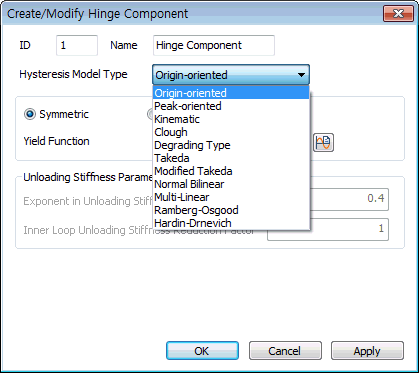
Hysteresis
Model Type
-
Origin-oriented : Response
points at the initial loading move along
a trilinear skeleton curve. Response points
at unloading move toward the origin and
again move along the skeleton curve after
reaching the opposite skeleton curve.
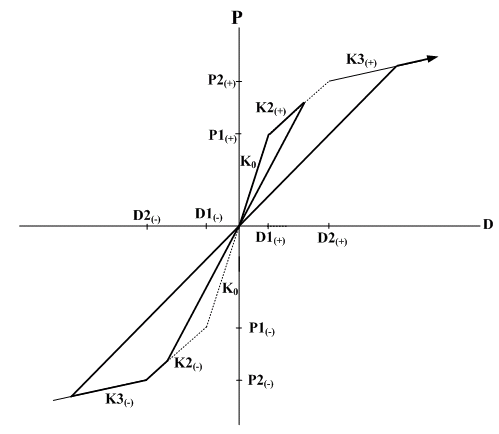
-
Peck-oriented : Response
points at the initial loading move along
a trilinear skeleton curve. Response points
at unloading move toward the point of
maximum displacement on the opposite side.
If the first yielding has not occurred
on the opposite side, the response points
move toward the first yielding point on
the skeleton curve.

-
Kinematic : Response points
at the initial loading move along a trilinear
skeleton curve. The unloading stiffness
is identical to the elastic stiffness.
It shows the tendency of strength increase
with the increase in loading. This is
used to model the Bauschinger effect of
metallic materials. Accordingly, it is
cautioned that energy dissipation may
be overestimated for concrete. Due to
the characteristic of the model, only
the positive (+) and negative (-) symmetry
is permitted for the strength reduction
ratios after yielding.
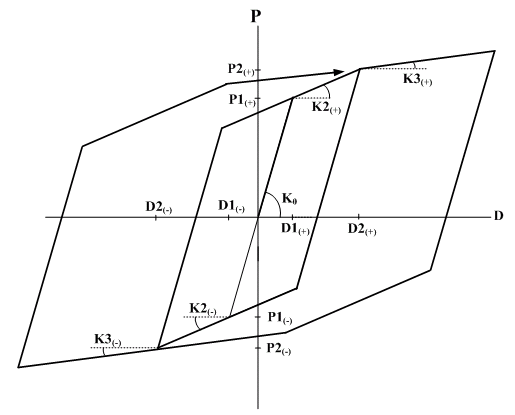
-
Clough : Response points
at the initial loading move along a bilinear
skeleton curve. Unloading stiffness is
obtained from the elastic stiffness reduced
by the equation below. As the deformation
progresses after yielding, unloading stiffness
reduces gradually.

where,
KR
: unloading stiffness
Ko
: elastic stiffness
Dy
: yield displacement in the zone where
unloading begins
Dm
: maximum displacement in the zone where
unloading begins
(In
the zone where yielding has not occurred,
replace it with the yield displacement)
 : constant for determining
unloading stiffness : constant for determining
unloading stiffness
If the sign of loading
changes in the process of unloading, response
points move toward the point of maximum
displacement in the zone of progressing
direction. If yielding has not occurred
in this zone, the response points move
toward the yield point on the skeleton
curve. If unloading becomes loading without
changing the loading sign, the response
points move along the unloading path.
If the loading continually increases,
loading continues on the skeleton curve
again.
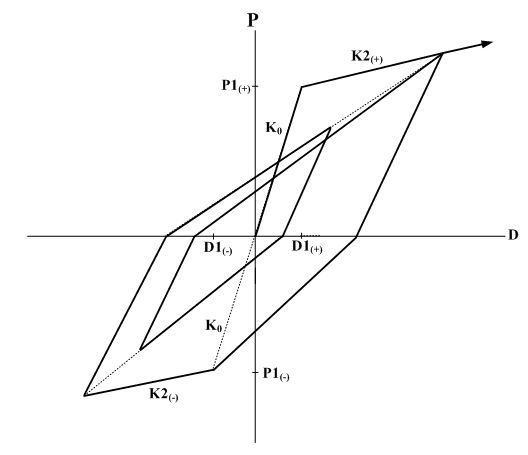
-
Degrading : Response points
at the initial loading move along a trilinear
skeleton curve. The load-displacement
coordinates at unloading move to the path
of reaching the maximum deformation point
on the opposite side due to the change
of unloading stiffness once in the middle.
If yielding has not occurred on the opposite
side, the first yielding point is assumed
to be the maximum deformation point.

-
Takeda : Response points
at the initial loading move along a tetralinear
skeleton curve. If the current displacement
or deformation, D, does not exceed D3,
the hysteresis rules are identical to
the Original Taketa hysteresis. If the
current displacement or deformation, D,
exceeds D3, response points move along
the slope K4. For unloading, response
points move by the same rules as the Original
Taketa hysteresis. The Takeda tetralinear
hysteresis model can be applied to beam
element and General Link of Spring Type
of Lumped Type and Distributed Type.
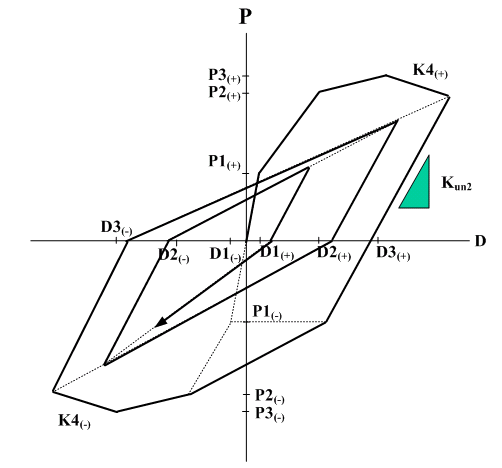
-
Modified Takeda : Response
points at the initial loading move along
a trilinear skeleton curve. If the current
displacement or deformation, D, exceeds
D2 for the first time or the maximum deformation
point up until now, response points move
along the trilinear skeleton curve. If
unloading takes place from this straight
line toward the opposite direction, the
points move along the slope Kun2
until the point of the restoring force
becoming 0. If the restoring force goes
beyond the 0 point, the points move toward
the maximum deformation point on the opposite
side. Even in the case where unloading
takes place from the straight line directed
toward the maximum deformation point from
the point of the 0 restoring force, the
points move along the slope Kun2
until the points reach the 0 restoring
force. After the point of 0 restoring
force is passed, the points move toward
the maximum deformation point on the opposite
side. The Modified Takeda type hysteresis
model can be applied to beam element and
General Link of Spring Type of Lumped
Type and Distributed Type.
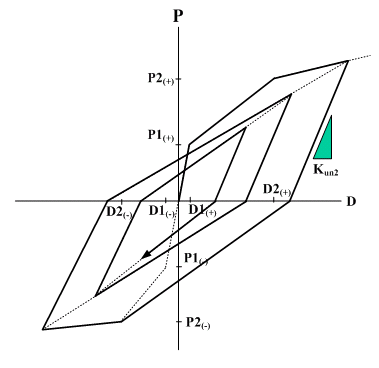 
-
Normal Bilinear : Response
points at the initial loading move along
a bilinear skeleton curve. The unloading
stiffness is identical to the elastic
stiffness. The Normal Bilinear type hysteresis
model can be applied to beam element and
General Link of Spring Type of Lumped
Type and Distributed Type.
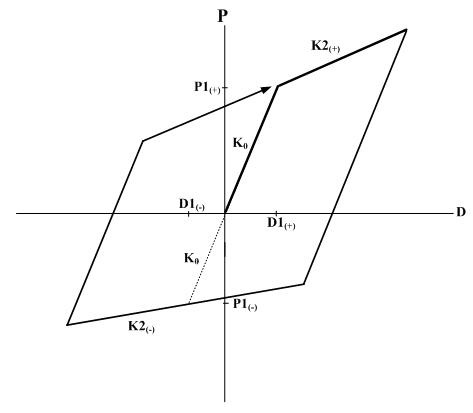
-
Modified Ramberg-Osgood :


-
Modified Hardin-Drnevich :

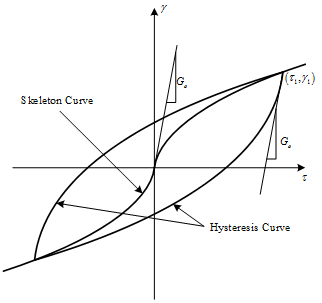
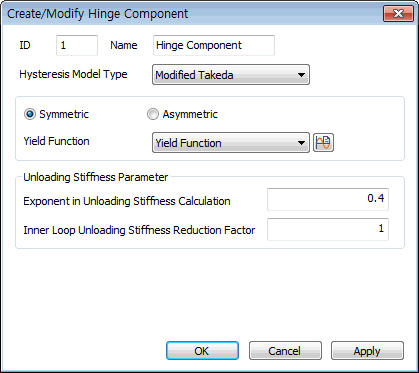
Symmetric
/ Asymmetric
: Select the type of Skeleton Curve.
Yield
Function
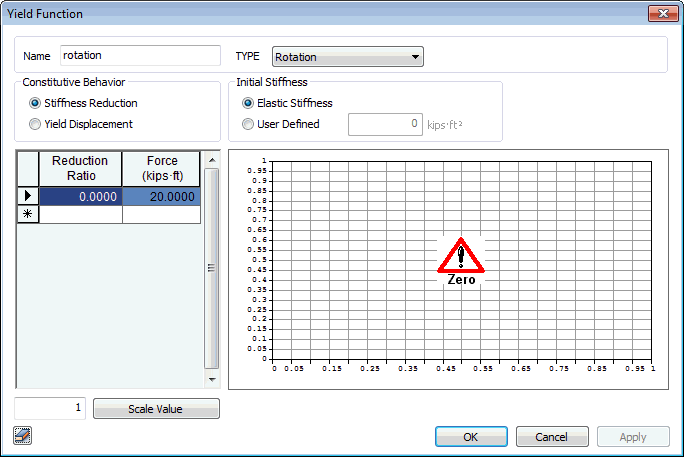
- Stiffness Reduction Ratio : Enter
the stiffness reduction ratios of a sloped
skeleton curve when Strength - Stiffness
Reduction Ratio is selected for Input
Type.
- Yield Displacement : Enter the yield
displacement of a sloped skeleton curve
when Strength - Yield Displacement is
selected for Input Type.
- Force (Yield Strength) : Yield strength
is specified. It is user defined based
on material and section properties. The
user specifies positive (+) values regardless
of tension (t) or compression (c). The
program treats compression as negative
(-) internally.
Unloading
Stiffness Parameter
Exponent
in Unloading Stiffness Calculation:
This is an option used to determine the
unloading stiffness of the outer loop
used in the Clough and Takeda type models
among hysteresis models of skeleton curves.
This is used to reflect the effect of
reduction in stiffness, which occurs as
the deformation progresses after yielding.
The unloading stiffness is determined
by the elastic stiffness reduced by the
yield displacement and maximum displacement
in the zone where unloading begins and
the exponent entered here.
Inner
Loop Unloading Stiffness Reduction Factor:
This is used to determine the unloading
stiffness of the inner loop. The inner
loop is formed when unloading occurs before
reaching the target point on the skeleton
curve while reloading after the loading
sign changes in the process of unloading.
The unloading stiffness of the inner loop
is calculated by multiplying the unloading
stiffness of the outer loop by the reduction
ratio for the unloading stiffness of the
inner loop.
 Hinge Components (Multi) Hinge Components (Multi)

- P-M Interaction
Curves : Enter the P-M interaction curve
data required to calculate 3-dimensional
yield surfaces. All strength values must
be entered with positive sign. Sign convention
for plotting P-M curve is positive for
compression and negative for tension.
Strengths
for the 1st P-M Interaction Curves
PC(t):
First yield strength subject to pure tension
force
PC(c):
First yield strength subject to pure compression
force
PCBy:
Axial force at the time of balanced failure
in the first yield interaction curve for
the y-axis moment of the section
PCBz:
Axial force at the time of balanced failure
in the first yield interaction curve for
the z-axis moment of the section
MCy,max:
Maximum bending yield strength in the
first yield interaction curve for the
y-axis moment of the section
MCz,max:
Maximum bending yield strength in the
first yield interaction curve for the
z-axis moment of the section
Strengths
for the 2nd P-M Interaction Curves
PY(t):
Second yield strength subject to pure
tension force
PY(c):
Second yield strength subject to pure
compression force
PYBy:
Axial force at the time of balanced failure
in the second stage yield interaction
curve for the y-axis moment of the section
PYBz:
Axial force at the time of balanced failure
in the second yield interaction curve
for the z-axis moment of the section
MYy,max:
Maximum bending yield strength in the
second yield interaction curve for the
y-axis moment of the section
MYz,max:
Maximum bending yield strength in the
second yield interaction curve for the
z-axis moment of the section
- Approximation
of Yield Surface Shape : On the basis
of P-M interaction curve, the parameters
for 3-dimensional yield surface are either
user defined or auto-calculated. If some
items are auto-calculated and the remainder
is to be user defined, Auto-calculation
should be performed first, and then necessary
items can be modified after converting
to User Input. In case of Alpha, only
user defined entry is possible. The value
of each parameter is used in the equation
of yield surface displayed in the dialog
box.
Beta y, Beta
z, Gamma: Being the exponential powers
of P-My or P-Mz interactions, different
values can be entered for the first and
second yields. For Beta y and Beta z on
the other hand, two separate values representing
the ranges of larger and smaller axial
forces relative to the axial force at
the time of balanced failure can be entered.
Alpha:
Exponent for My-Mz interaction for the
1st
and 2nd
yielding
- Stiffness Reduction
Ratio : Enter the stiffness reduction
ratios of a sloped skeleton curve when
Strength - Stiffness Reduction Ratio is
selected for Input Type.
α1:
Ratio of stiffness immediately after the
first yielding divided by the initial
stiffness
α2:
Ratio of stiffness immediately after the
second yielding divided by the initial
stiffness
- Initial Stiffness
: The initial stiffness used in inelastic
analysis is either selected or entered
by the user.
Elastic
Stiffness: elastic stiffness
of a member is used as the initial stiffness
for inelastic analysis.
User
Defined: the user directly
enters the initial stiffness if the Input
Type is Strength - Stiffness Reduction
Ratio.
|
